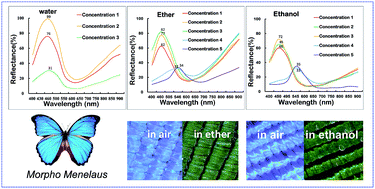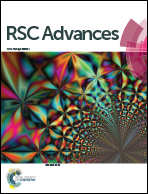Unparalleled sensitivity of photonic structures in butterfly wings†
Abstract
Butterflies are famous for their brilliant iridescent colors, which arise from the unparalleled photonic nanostructures of the scales on their wings. In this paper, the sensitivity characteristics of the photonic structures in butterfly wings to surrounding media were found. First, it was shown that the iridescent scales of Morpho menelaus butterfly give a different optical response to surrounding vapours of water, ether and ethanol. Then, the ultra-depth three-dimensional microscope and FESEM were used to observe the morphology and nanostructures of butterfly wing scales. The high spectral response characteristics were identified by using an Ocean Optics spectrometer USB4000. It was found that the reflectance spectra of the Morpho menelaus butterfly scales could provide information about the nature of the surrounding vapours. Afterwards, the theory of multilayer-thin-film interference was used to analyse the mechanism of this sensitivity. It was determined that the multilayer-thin-film interference structure constituted by alternating films with high and low refractive indexes, leading to the sensitivity of butterfly wings. The refractive indexes of surrounding media play an important role in gas sensitivity. These characteristics dramatically outperform those of existing nano-engineered photonic sensors and may have potential in the design of efficient and high sensitivity optical gas sensors.


 Please wait while we load your content...
Please wait while we load your content...